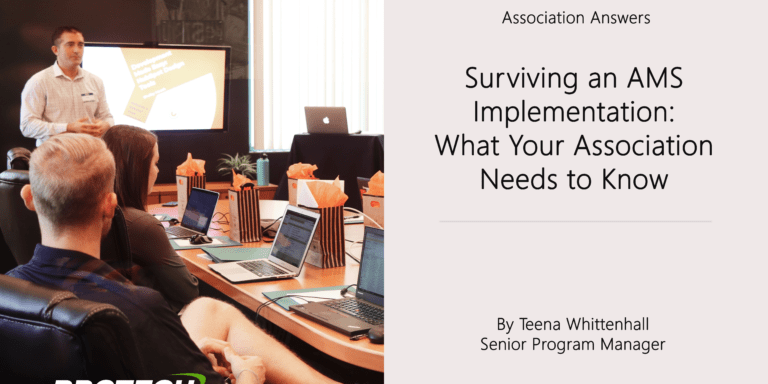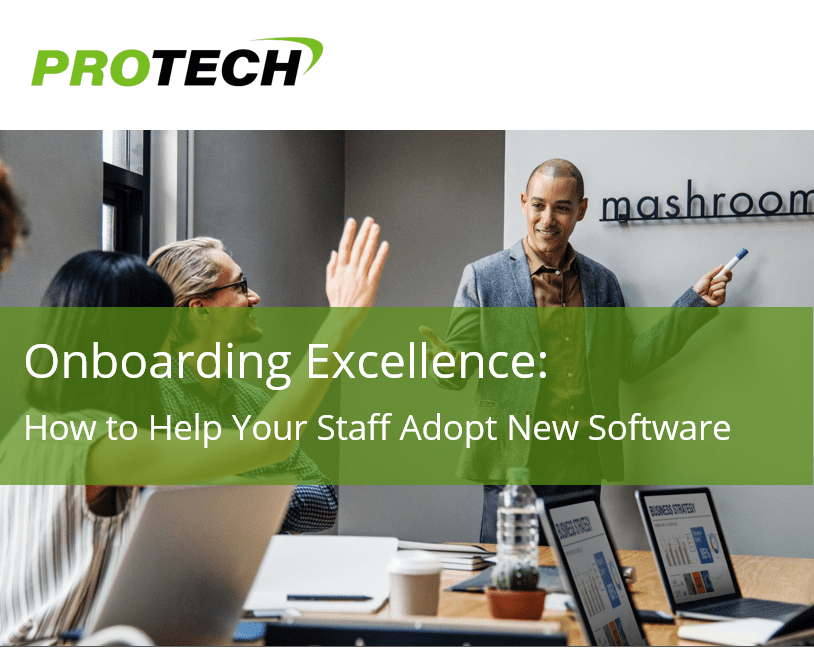
By Teena Whittenhall – Senior Program Manager
It sure feels great when you officially select your next association management software, doesn’t it? But while you revel in your success and dream of the ways your association can improve business processes, don’t forget to plan for the implementation.
After helping countless associations implement new systems, I’ve worked with organizations that have a winning approach, and those that do not. What’s often missing is not only the focus and leadership needed to make the project work, but clear and realistic mindset needed for success.
In this blog post, I’ll reveal my top tips for a successful AMS implementation, helping your team not only survive its AMS implementation, but thrive thereafter.
4 Steps for a Successful AMS Implementation
1 – Explain Why Change is Needed
How did your member-based organization arrive here? Why did you need a new association management system in the first place? Often, it’s because business processes on your association’s current system have become too complex. Or, staff productivity has dropped due to an overly complicated or incredibly simple system.
On the other hand, it could be outside forces like marketplace changes that force the association to adapt to stay relevant to its constituency. Whatever the reason, it’s certainly enough to spur a major change at your association. So why not use that narrative to your advantage?
Start by setting the stage for the new software implementation project by reminding your team of current processes and how’ll they will need to change. Those mundane tasks that occupied too much of your team’s day will now be automated, freeing the team up to tackle more exciting challenges.
Some staff will eagerly embrace this change. Others? Not so much. That’s why the overarching business objective — the “Why we MUST make this change,” sentiment — needs to be reiterated and made prominent.
2 – Set Realistic Expectations
When implementing any new software, it’s tempting to view it as the savior for all of your association’s problems. But the extent to which any AMS or ERP system will benefit the organization correlates with the level in which it is adopted and embraced by the entire staff.
System adoption often means letting go of processes and procedures that are familiar and comfortable and embracing the design of the new system. It’s not uncommon for the new processes and procedures to seem more complicated, more difficult, or “require more clicks” then the current process — at least at first. The overall success of new system adoption cannot be measured by individual task efficiency measurement. Some processes may take longer, while others will be much quicker, or eliminated altogether. By tying the end result directly to the project drivers and objectives, and acknowledging that processes will — not may — change to get there, you will set realistic expectations on the change impact to each person individually.
3 – Understand the Fear
It’s entirely natural for a new system to trigger some resistance. After all, uncertainty is often what feeds our fears, and the potential failure to adapt to the new way of life at your association may have staff feeling like they’re standing on shaky ground.
Before implementation, acknowledge the fact that this project won’t be a cakewalk. Learning something new never is. But that’s OK, as long as the leadership team is openly realistic.
Make sure the team feels a sense of security by explaining that any short-term obstacles are worth the long-term value. Also, let your employees know that it’s OK if they don’t pick up every aspect of the software right away, as some people learn faster than others, but be vigilant in identifying users that will need extra support and practice to feel confident.
Try pairing the power users and champions among your staff with the people who are little less comfortable with the change. The power users will learn more as they teach, and the less
comfortable users will benefit from the additional insight.
4 – Commit the Time and Effort
Nearly two out of every five organizations has seen an IT project fail. There are a lot of variables that lead to such an unfortunate statistic, but many of them are avoidable with proper guidance from your association’s software vendor and a clear understanding that most IT projects are 20 percent technology and 80 percent “people projects.”
Encouraging, supporting,and even mandating time for your team to learn the new system — early and often — is critical to the success of your implementation. Remember, learning new software requires patience and dedication. By giving new AMS users the time to focus on the software and gain hands-on experience, they won’t feel pressured to multitask during training and will maintain focus.
For more tips to implementing your new association management software, check out this free on-demand webinar: “Onboarding Excellence: How to Help Your Staff Adopt New Software.”
About the Author: Teena has more than 14 years of experience helping associations adopt and implement new systems, leading them to improved member engagement and heightened productivity.

